|
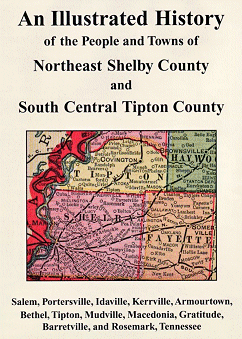
From An Illustrated History of the People and
Towns of Northeast Shelby County
and Southeast Tipton County
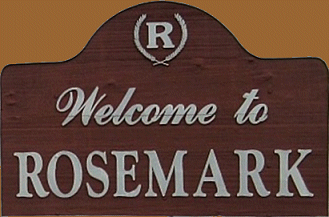
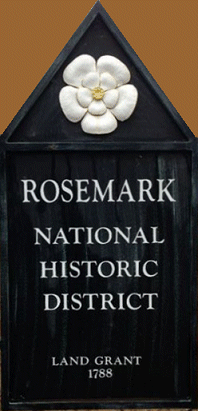 Rosemark was not this community’s original name. The area was named Richland (rich land) to reflect the unusually rich soil, generally Memphis silt loam, and the relatively flat topography found here. Richland changed its name to Rosemark in 1890 when it was determined that it could not become a post office, because there was already a Richland post office in Tennessee. New names were proposed at a town meeting at Thompson’s General Store, placed in a hat, and the name Rosemark, submitted by Mr. Tarkington, was drawn. The named Richland was retained by the Associate Reformed Presbyterian Church, the Masonic Lodge and “Thompson’s” Store.
Rosemark is located at the intersection of four major land grants made to John Gray Blount and Thomas Blount on July 18, 1788. On February 26, 1891, William L. Thompson was appointed postmaster for the newly named Rosemark post office. The post office was established in Thompson’s Store where it was maintained for the next sixteen years. Rosemark was not this community’s original name. The area was named Richland (rich land) to reflect the unusually rich soil, generally Memphis silt loam, and the relatively flat topography found here. Richland changed its name to Rosemark in 1890 when it was determined that it could not become a post office, because there was already a Richland post office in Tennessee. New names were proposed at a town meeting at Thompson’s General Store, placed in a hat, and the name Rosemark, submitted by Mr. Tarkington, was drawn. The named Richland was retained by the Associate Reformed Presbyterian Church, the Masonic Lodge and “Thompson’s” Store.
Rosemark is located at the intersection of four major land grants made to John Gray Blount and Thomas Blount on July 18, 1788. On February 26, 1891, William L. Thompson was appointed postmaster for the newly named Rosemark post office. The post office was established in Thompson’s Store where it was maintained for the next sixteen years.
Rosemark is an intact representative example of a rural agricultural district in Shelby County. Cotton production was the driving force behind the development of the town and the resulting commercial and residential development of the community. Tied to agriculture was the industrial infrastructure represented by the cotton gin at the heart of the district. Agricultural development in Rosemark continued to evolve in the 20th century, particularly with diversification efforts in the Depression era and mechanization during the post-World War II period. The district is significant architecturally as it represents an early to
mid-twentieth century rural historic district with numerous intact farmhouses and associated agricultural buildings, several intact commercial structures, and an intact gin and lint house. With major urban sprawl throughout Shelby County, this is one of the few intact rural communities remaining. The period of significance ranges from c. 1890 with the construction the first extant building in the district until 1963.
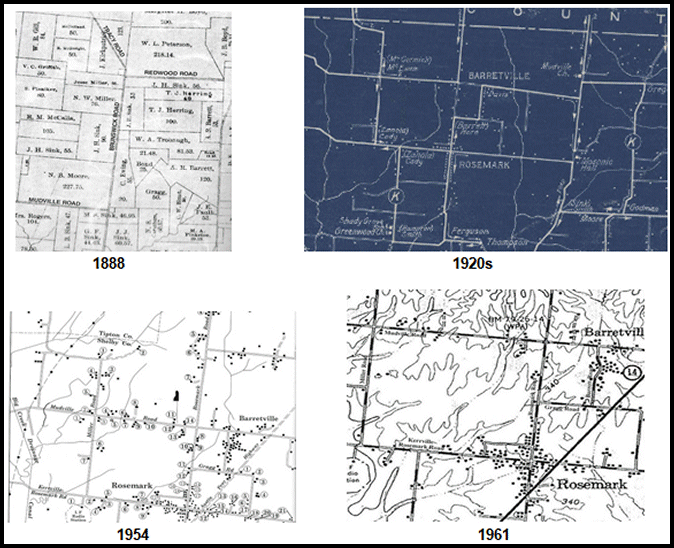
Rosemark is bounded by the settlement of Big Creek on the west, Barretville on the north, Mudville and Stewartville on the east. The central intersection is Rosemark Road and Kerrville-Rosemark Road, with Austin Peay Highway (TN 14) running along the eastern side of town from Raleigh to Tipton County.


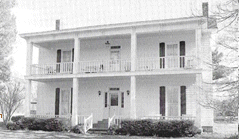
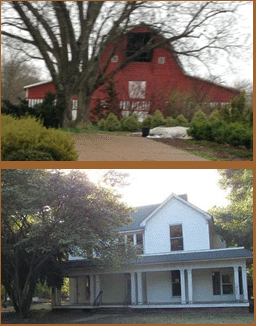 |
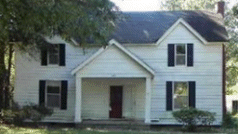 |
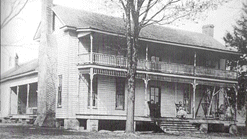
 |
|
By
the 1830s, settlers were beginning to
arrive in the Rosemark area. By the
1840s, George Smith had established a
plantation along what is the southern
end of Rosemark Road, the Stewart
plantation existed on Brunswick Road to
the east, and the James McNitt Alexander
plantation was west of Big Creek. It was
the arrival in the 1850s of the Gragg,
McCalla, Raymond, McEwen, Wilson, Reid,
Barret, Witherington, and other families
that began the creation of a
non-plantation based community. |
|
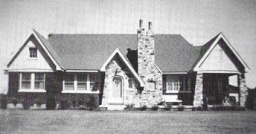 |
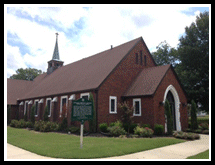 |
By 1859 steps were taken to create the
first church and school in the new
community. On August 16, 1861, fifteen
men signed a pledge for the construction
of an Associate reformed Presbyterian
Church and a school near what is now the
intersection of Rosemark Road and
Kerrville-Rosemark Road. While a school
building appears to have been built,
construction of the church was delayed
because of the intervening War between
the States. At the close of the War in
1865, interest in building a church was
renewed. |
In the 1800s this area, known for its rich and
fertile farm land, attracted settlers from the
Carolinas, East and Middle Tennessee who were
pioneering the “Great West.” Associate Reformed
Presbyterians (ARP) arrived and established
Salem Church in Tipton County. In 1856 Salem
fostered a mission station in a new community,
now known as Rosemark, in Shelby County. ARP
adherents from Lincoln County, Tennessee soon
followed and began worshipping in the home of
Robert and Nancy McCalla.

On August 16, 1861, fifteen men pledged to build
both “a church and a schoolhouse” on the site.
The land had been donated by Robert McCalla. The
covenanting families were Gragg, Hutchison,
McCalla, McQuiston, Parkinson, Raymond, Rogers,
and Sloan. Delayed by the Civil War, their
efforts resumed when Rev. J.H. Strong of Salem
Church was called to organize the new
congregation. In the fall of 1866, Memphis
Presbytery formally recognized Richland ARP
Church. The present structure, the third
sanctuary, was completed in 1950 and the
fellowship hall in 1993. The congregation has
remained on this site throughout its history.

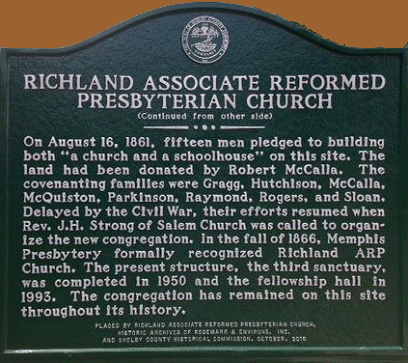
In the early days, Richland had a saw mill with
a mill pond,
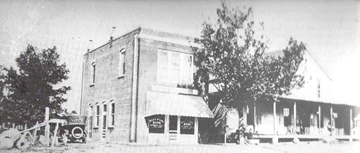 for the floating of logs, in the
center of the town, as well as a church and
school. A second church, Rosemark Presbyterian
Church, U.S., was added in 1878. Merchants
arrived and Richland Farmers’ Mercantile
Association (Thompson’s) Store and Moore
Brother’s Store, both general mercantile stores,
were constructed and John Cole opened a small
store. These three stores were located on
Rosemark Road just south of the intersection
with Kerrville-Rosemark Road. The Rosemark Bank
building with apartments upstairs was
constructed next to Thompson’s Store. A corral
was built next to the store for livestock that
would be “furnished” to sharecroppers. A cotton
gin was constructed on Moore Brothers’ property
next to the corral. for the floating of logs, in the
center of the town, as well as a church and
school. A second church, Rosemark Presbyterian
Church, U.S., was added in 1878. Merchants
arrived and Richland Farmers’ Mercantile
Association (Thompson’s) Store and Moore
Brother’s Store, both general mercantile stores,
were constructed and John Cole opened a small
store. These three stores were located on
Rosemark Road just south of the intersection
with Kerrville-Rosemark Road. The Rosemark Bank
building with apartments upstairs was
constructed next to Thompson’s Store. A corral
was built next to the store for livestock that
would be “furnished” to sharecroppers. A cotton
gin was constructed on Moore Brothers’ property
next to the corral.
 |
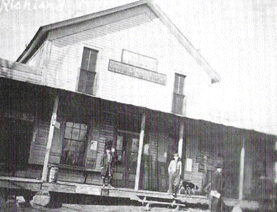 |
|
Thompson’s General Store |
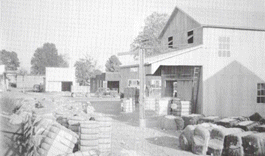 |
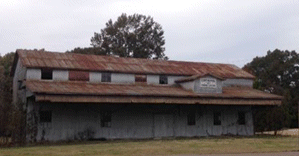 |
|
Moore Brothers Gin |
A small
group of Rosemark (Richland) residents decided
to organize a Presbyterian church. They chose a
Christian denomination that originally came to
the “new world” in the 1700s. It would not be
easy. Memphis presbytery had difficulty
acquiring a quorum due to the deaths of so many
ministers and elders from yellow fever. Such sad
events meant that sometimes church business just
had to wait.
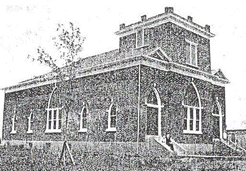 |
 |
In 1878,
a church named Big Creek Presbyterian Church was
officially organized. The new church was located
in a white frame building on the southeast
corner of the intersection of
 Miller and
Mudville Roads. Built on a slight hill, it faced
Mudville Road. While the new church was being
built, the small congregation often met for
worship in their homes. After thirty-five years
of faithful service in the original location,
the congregation decided to build a new brick
church at 8592 Kerrville-Rosemark Road. A member
of the Southern Presbyterian denomination (P.C.U.S.),
the church held its first service in the new
building in 1918. With the reunion of the
Northern and Southern Presbyterian churches in
1983, the original relationship that existed
before the Civil War was restored. Rosemark
First Presbyterian Church, P.C.U.S.A., is now
one with many other Presbyterian churches
throughout the nation. Miller and
Mudville Roads. Built on a slight hill, it faced
Mudville Road. While the new church was being
built, the small congregation often met for
worship in their homes. After thirty-five years
of faithful service in the original location,
the congregation decided to build a new brick
church at 8592 Kerrville-Rosemark Road. A member
of the Southern Presbyterian denomination (P.C.U.S.),
the church held its first service in the new
building in 1918. With the reunion of the
Northern and Southern Presbyterian churches in
1983, the original relationship that existed
before the Civil War was restored. Rosemark
First Presbyterian Church, P.C.U.S.A., is now
one with many other Presbyterian churches
throughout the nation.
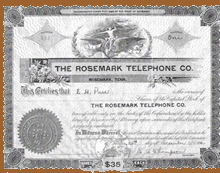 Rosemark
Telephone Company & Rosemark Telephone Exchange
Museum Rosemark
Telephone Company & Rosemark Telephone Exchange
Museum
In 1911 the community founded a cooperative
telephone company, the Rosemark Telephone
Company, which had its own building, operators
and maintenance personnel. It was located on
Kerrville-Rosemark Road. The Rosemark Telephone
Company bound Rosemark and nearby communities
together while linking them with the rest of the
country. The cost of a telephone was $2.00 per
month, and it cost 10 cents to place a call to
Memphis.
Today,
the Rosemark Telephone Exchange Museum is
located at the intersection of
Kerrville-Rosemark Road and Rosemark Road, and
is open on selected dates for viewing.
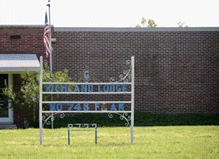 On
December 31, 1892, the Grand Lodge of Tennessee
chartered # 576 of Free & Accepted Masons to
meet at Stewartville, located on the east side
of Brunswick Road just north of the intersection
of Kerrville-Rosemark Road. On
December 31, 1892, the Grand Lodge of Tennessee
chartered # 576 of Free & Accepted Masons to
meet at Stewartville, located on the east side
of Brunswick Road just north of the intersection
of Kerrville-Rosemark Road.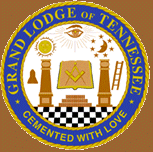 A factor led to the
decline of Lodge # 576 was that many of its
members were called to service during World War
II. After World War II, there was interest in
re-establishing a local Masonic lodge and a
charter creating Richland Lodge # 748 F. & A. M.
in 1948. The lodge building was completed in
1955 on land next to the Rosemark School. The
lodge still fulfills its charitable functions,
raising money for worthwhile causes and
providing a place for fellowship, education and
advancement of its members. A factor led to the
decline of Lodge # 576 was that many of its
members were called to service during World War
II. After World War II, there was interest in
re-establishing a local Masonic lodge and a
charter creating Richland Lodge # 748 F. & A. M.
in 1948. The lodge building was completed in
1955 on land next to the Rosemark School. The
lodge still fulfills its charitable functions,
raising money for worthwhile causes and
providing a place for fellowship, education and
advancement of its members.
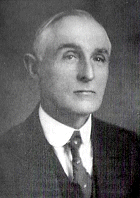 Dr. Peter
John Flippin was born in Oakland, Tennessee and
graduated in 1897 from the Memphis Hospital
Medical College, later the University of
Tennessee Medical School. Dr. Flippin provided
medical care to white and African-American
citizens of Rosemark and surrounding communities
for five decades and was honored by the
University of Tennessee for providing fifty
years of medical service. “Doc” Flippin
customarily extended credit to members of the
community, forgoing payment until after the
crops were harvested, or accepted whatever
payment they could afford. He was one of the
leading citizens of the community, serving as a
successful farmer, church elder, bank
vice-president and member of numerous
organizations. He delivered over 1300 babies in
northern Shelby and southern Tipton Counties,
many of whose descendants still live in the
area. Dr. Flippin retired from medical practice
in 1947. He died in Rosemark in 1950, leaving a
legacy of service to the people of the
community. Dr. Peter
John Flippin was born in Oakland, Tennessee and
graduated in 1897 from the Memphis Hospital
Medical College, later the University of
Tennessee Medical School. Dr. Flippin provided
medical care to white and African-American
citizens of Rosemark and surrounding communities
for five decades and was honored by the
University of Tennessee for providing fifty
years of medical service. “Doc” Flippin
customarily extended credit to members of the
community, forgoing payment until after the
crops were harvested, or accepted whatever
payment they could afford. He was one of the
leading citizens of the community, serving as a
successful farmer, church elder, bank
vice-president and member of numerous
organizations. He delivered over 1300 babies in
northern Shelby and southern Tipton Counties,
many of whose descendants still live in the
area. Dr. Flippin retired from medical practice
in 1947. He died in Rosemark in 1950, leaving a
legacy of service to the people of the
community.
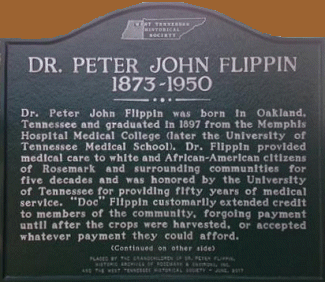 |
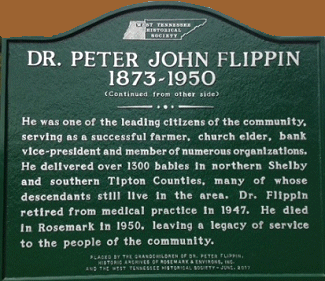 |
Pleasant Union Cumberland Presbyterian Church
has over 100 years of history. At first,
Mudville Presbyterian was the name of the
church. This was due to the location and to
please some of the faithful members. It has been
told that a huge mud hole was in front of the
church back in the 1880s and that is when the
name Mudville was given to the church. The
earliest record that has been found was from
1867 when Mr. and Mrs. John Sink, part of the
Farley Hill family, became the first couple to
marry in the church.
The first
building was erected some time before 1867 and
stood near the center of the Mudville Cemetery
facing south. In 1912, the church was moved to
the present location and was remodeled under
contractor William McCreight, whose name runs
throughout the history of the church. In 1936,
the church was destroyed by fire due to a defect
in the coal stove used for heating. Everything
was burned and all church records were
destroyed. During the time the new building was
under construction, Sunday School members met in
various homes. In less than a year, the church
members erected the present church building.
 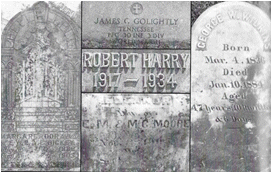 On the north and south side of Pleasant
Union Cumberland Presbyterian Church are
situated two cemeteries – Rosemark Cemetery
and Mudville Cemetery. Located on the north
side, the cemetery known as both Mudville
and Pleasant Union has been in existence
since the mid-1880s. The church and cemetery
separated themselves legally and financially
several years ago, and the cemetery assumed
the name Mudville Cemetery.
On the north and south side of Pleasant
Union Cumberland Presbyterian Church are
situated two cemeteries – Rosemark Cemetery
and Mudville Cemetery. Located on the north
side, the cemetery known as both Mudville
and Pleasant Union has been in existence
since the mid-1880s. The church and cemetery
separated themselves legally and financially
several years ago, and the cemetery assumed
the name Mudville Cemetery.
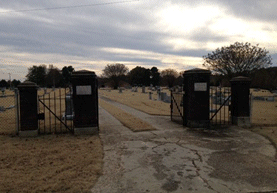
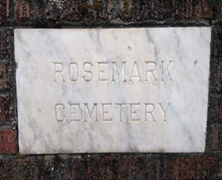  Rosemark Cemetery was established in 1909.
The initial cemetery property was deeded to
Richland Associate Reformed Presbyterian
Church in 1907. Prior to the development of
the cemetery, Rosemark residents and church
members were most often buried in either
private family cemeteries, Salem A.R.P.
Cemetery or in the Mudville Cemetery. A
cemetery committee recommended the purchase
of two acres just south of Pleasant Union
Church on Brunswick Road. A plat was drawn
by T.C. McQuiston on linen cloth, and that
drawing remains in the hands of those who
oversee the cemetery. In 1976, a perpetual
care fund was established and is managed
through Richland A.R.P. Church.
Rosemark Cemetery was established in 1909.
The initial cemetery property was deeded to
Richland Associate Reformed Presbyterian
Church in 1907. Prior to the development of
the cemetery, Rosemark residents and church
members were most often buried in either
private family cemeteries, Salem A.R.P.
Cemetery or in the Mudville Cemetery. A
cemetery committee recommended the purchase
of two acres just south of Pleasant Union
Church on Brunswick Road. A plat was drawn
by T.C. McQuiston on linen cloth, and that
drawing remains in the hands of those who
oversee the cemetery. In 1976, a perpetual
care fund was established and is managed
through Richland A.R.P. Church.
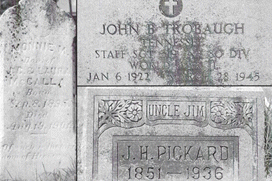

 Later Anthony Chapel School was built in the
area, west of Brunswick Road and just north
of Mulberry Road, to educate
African-American children from Mudville,
Barretville and Rosemark. In May, 2015, a
historical marker was dedicated by Historic
Archives of Rosemark and Environs, Inc. and
the Shelby County Historical Commission
stating:
Later Anthony Chapel School was built in the
area, west of Brunswick Road and just north
of Mulberry Road, to educate
African-American children from Mudville,
Barretville and Rosemark. In May, 2015, a
historical marker was dedicated by Historic
Archives of Rosemark and Environs, Inc. and
the Shelby County Historical Commission
stating: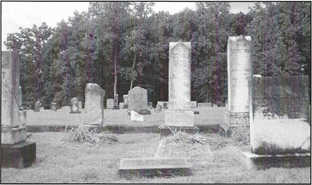
"Anthony Chapel School, Greenwood AME Church
& Cemetery. At the turn of the 20th century,
John Wesley Stewart, an African-American
farmer, began lobbying for a school to
educate African-American children in the
Greenwood community. At the time the
children were either taught by itinerant
teachers or they walked to Tipton County
schools. In 1925 the community became part
of Shelby County in a boundary shift. In
1927 the family of Paul Barret, a county
school board member, sold a tract of family
land for the school. A year later a two-room
building was opened and named Anthony Chapel
Elementary School for Anthony R. Barret, an
early settler of the area and Paul Barret’s
grandfather. Near this site was the original
brush-arbor Greenwood Cemetery with graves
of individuals born before the 1865
Emancipation Proclamation."
Greenwood AME Church originated as a brush-arbor
church north of Mulberry Road in either 1874 or
1878. A wood frame building which faced the east
was constructed. At that time, Mulberry Road was
a dirt road and the road to the church was a
steep trail. Due to the difficulty of reaching
the church grounds, the building was torn down
in 1924 and the lumber was used to construct a
new church at the current site of the Greenwood
A.M.E. Church at 8017 Donnell Road, a more
accessible location.
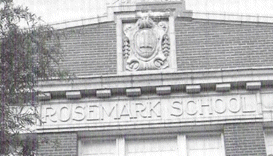 |
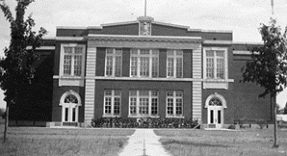 |
Richland
School opened in 1892 in a small frame building
built on the property of the Richland ARP
Church. The early school was always the center
of community activities. In 1912, wagonettes
provided transportation allowing consolidation
of students. Rosemark School grew from an
elementary school to a high school and remained
a high school until 1930 when it reverted to a
county elementary school. After the closure of
the elementary school in 1967, the property was
sold to a private, Tipton-Rosemark Academy.
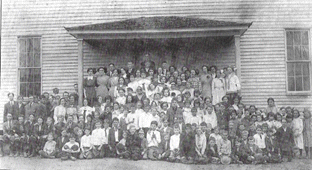 |
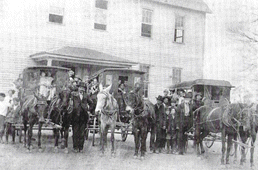 |
 Tipton-Rosemark Academy, dual-accredited through
the Southern Association of Independent Schools
and the Southern Association of Colleges and
Schools, began in 1965, when a group of citizens
became concerned about the quality of their
children's education because prayer and the
Bible had been removed from public schools. It
was their desire that Christian teaching remain
a part of their children's education. They
established an elementary school (1-8) in a
house in Munford and named it Tipton Academy. A
new school facility was built in Brighton in
1967 and doubled in 1970 with a kindergarten
facility being added. In 1970 the Academy also
purchased Rosemark School from Shelby County to
expand its system to include grades 9-12 and
named this Rosemark Academy.
Tipton-Rosemark Academy, dual-accredited through
the Southern Association of Independent Schools
and the Southern Association of Colleges and
Schools, began in 1965, when a group of citizens
became concerned about the quality of their
children's education because prayer and the
Bible had been removed from public schools. It
was their desire that Christian teaching remain
a part of their children's education. They
established an elementary school (1-8) in a
house in Munford and named it Tipton Academy. A
new school facility was built in Brighton in
1967 and doubled in 1970 with a kindergarten
facility being added. In 1970 the Academy also
purchased Rosemark School from Shelby County to
expand its system to include grades 9-12 and
named this Rosemark Academy.
In 1986,
the seventh and the eighth grades were moved to
the high school campus as the initial step in
consolidation of all grades (K-12) on the
Rosemark campus. During the 2011-2012 school
year as part of the "Many Dreams, One Vision"
campaign, the structure
housing the original gym was renovated into a
Performing Arts Center and Chapel. The 14,000
square-foot facility now features retractable
stadium-seating for 350 people, banquet seating
for 400, a 46 foot stage, concession stand, a
fine arts classroom, a construction area, and
prop and dressing rooms. A strong commitment to
the TRA vision continues today with alumni
families and new families still choosing
Tipton-Rosemark Academy for their children.
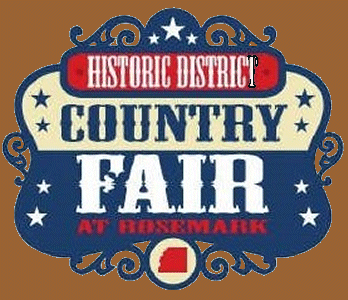
The annual Rosemark Country Fair is held on the
last Saturday of September at the intersection
of Rosemark Road and Kerrville-Rosemark Road.
Admission is FREE and there is Family Fun For
All.
* Farm Equipment, Antique Cars, Food Vendors,
Bee Exhibit, Livestock, RC Aircraft, Herding
Dogs,
Live Entertainment Artists, 4-H, Home & Garden
Exposition, 5k Run, Storytelling and Much More!
*
For information, directions, exhibitor forms,
etc. visit:
www.rosemarkhistoricdistrict.com or
Rosemark Historic District on
Facebook
Rosemark
Vineyards, 8605 Kerrville-Rosemark Road
 
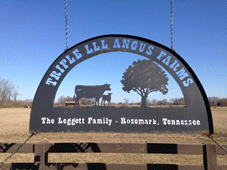 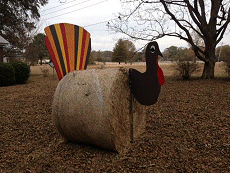
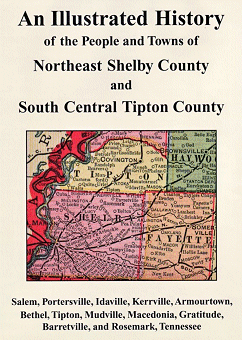 |
Excerpts from the jacket of An Illustrated
History of the People and Towns of Northeast
Shelby County and Southeast Tipton County by
Historic Archives of Rosemark and Environs (H.A.R.E.):
On October 19, 1818, the United States Congress
ratified the treaty with the Chickasaw Nation
ceding West Tennessee to the United States. What
followed was the creation of Shelby County
in1819 and, to its north, the creation of Tipton
County in 1823. Settlers followed quickly. Along
the border of Shelby and Tipton counties small
communities developed around churches, schools,
and country stores. This is the story of the
people who have lived there. Over the last 180
years most of the schools and some of the towns
of Northeast Shelby County and South Central
Tipton County have disappeared. The churches and
cemeteries remain and the land is still farmed.
This illustrated history attempts to capture the
stories of those people and places where they
lived. Through a series of articles and
interviews, maps, photographs, diaries, and
letters, you can experience the people who lived
on the farms and worked in the towns of Salem,
Portersville, Idaville, Kerrville, Armourtown,
Bethel, Tipton, Mudville, Macedonia, Gratitude,
Barretville, and Rosemark. |
 On June 14, 2013 the Rosemark Historic
District was placed in the National and
Tennessee Registers of Historic Places by
the National Park Service the United States
Department.
On June 14, 2013 the Rosemark Historic
District was placed in the National and
Tennessee Registers of Historic Places by
the National Park Service the United States
Department.
The Historic Archives of Rosemark and
Environs is a non-profit organization whose
mission is to document & preserve historic
information & items of the Rosemark region
for educational purposes. It is primarily
responsible for the creation of the Rosemark
Historic District. Please consider a tax
deductible contribution to help them
continue these efforts.
For more
information about H.A.R.E.
www.rosemarkhistoricdistrict.com
Or, on Facebook at
www.facebook.com/RosemarkHistoricDistrict
|